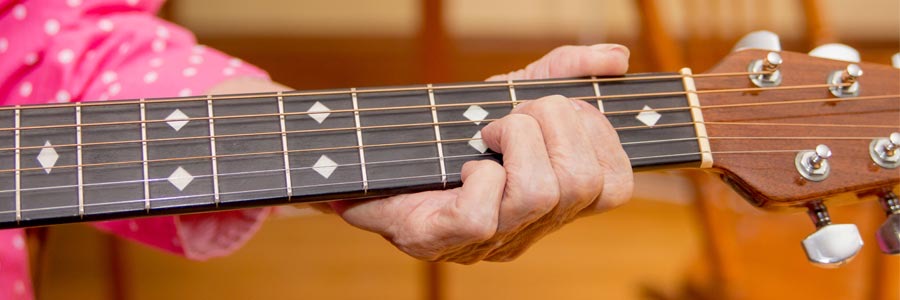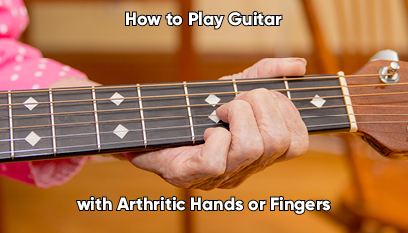
My wife’s 90-year-old grandmother has been drinking a glass of black cherry juice every morning for several decades now. It sounds weird, but she swears it keeps the arthritis in her hands at bay. This got me thinking about the impact of arthritis on guitar players.
For a serious guitarist, arthritis in the hands or fingers can be physically and emotionally devastating. Arthritis can also keep older people who want to start playing guitar from jumping in. The good news is that if your arthritis isn’t too advanced, there are lots of ways to modify your playing so it’s more comfortable. Some examples include playing with a capo, adjusting the action of your strings so it’s lower, using lighter strings, using alternative tunings, and playing slide guitar.
Disclaimer: This post is intended as general information. I’m not a doctor, and I don’t even play one on TV. Please consult an actual doctor for medical advice. In this case, an occupational therapist may be helpful as well.
Arthritis Basics
So what exactly is arthritis, anyway? Arthritis is a general term for chronic swelling in the joints. It typically causes stiffness, pain, and limited range of motion. The two most common types are osteoarthritis and rheumatoid arthritis.
Osteoarthritis (OA) is degenerative. It happens when the cartilage between bones wear down. It’s especially common in the hands, hips, and knees. OA is often caused by aging, but people can develop it when they have certain kinds of injuries, or when they carry excess weight. And some people are just genetically predisposed to it so they may develop AO without injuries or excess weight.
Rheumatoid arthritis (RA) is an autoimmune disease similar to lupus. With RA the joints are actually healthy, but the immune system attacks them as if they were a threat. This causes inflammation and pain. RA can affect a lot of different joints, such as the hands, wrists, elbows, shoulders, knees, and ankles. RA is more variable than OA, and typically involves flares followed by periods of remission. Due to the systemic nature of the disease, RA can also impact the lungs, heart, and other organs of the body.
Can Playing Guitar Cause Arthritis?
There is no evidence that playing an instrument makes a person any more likely to get arthritis. Keith Richards has osteoarthritis in his hands, but he could have developed the condition due to age or genetics without ever picking up a guitar. People who think playing guitar causes arthritis may be confusing arthritis with carpal tunnel or tendonitis. As always, it is important to play with proper form, and stretching, to prevent other kinds of injuries and joint damage.
Can Playing Guitar Relieve Arthritis Pain?
In many situations, yes! Frequent, low-impact movement has been shown in study after study to improve flexibility and strength. There is no cure for arthritis, but lots of people find that regularly playing guitar helps them manage their arthritis pain long-term. Les Paul himself played guitar with arthritis for 50 years!
Some Ideas for Making Playing the Guitar Less Painful for Those Living With Arthritis
As with most things, your mileage may vary. What works for you will depend on a lot of factors, including the severity of your arthritis and whether it affects your fretting hand or your picking hand (or both). Here are a few modifications you can try that have worked for others.

1) Set the tone (see what I did there?) for comfortable playing.
• Warm up before you play, both figuratively and literally. Try a deep heat muscle rub, or soak your hands in hot water. (Believe it or not, some guitarists with arthritis have found a lot of benefit from hot paraffin treatments at the spa!) Do stretches and scales before you play full songs.
• When you play, sit in a comfortable, ergonomic position. Tension in the back or legs can create tension in other areas of the body, so good posture is important.
• If you can, keep your environment warm and dry. With arthritis, cold and humidity are not your friends.
2) Modify the way you play so you can use less strenuous hand positions.
• Move away from full barre chords if your playing style doesn’t absolutely depend on it. Many open/”cowboy” chords are easier on the hands and require less pressure from fewer fingers.
• If your repertoire consists of many songs that have a mix of barre and open chords, investigate if using a capo will allow you to play those songs in the same key without using the barre chords.
If you don’t have a capo I’m a big fan of this one which you can find on Amazon.
• If you’re not a speed player already, this isn’t the time to become a disciple of Steve Vai. Slower playing is easier on your hands and wrists. If you are a speed player, or have always wanted to become one, proceed with caution and make sure you are warming up properly.
• Play with a straight wrist. To make this easier, try holding the guitar in more of a classical position.
• Where you’re fretting your notes can make a big difference in the amount of strength it takes to get a clean note. The closer to the fret your finger is, the less pressure you need to use.
• Slide playing may be easier for you to play for a longer duration, since there is less movement of individual fingers and no fretting of notes is required.
If you‘re interested in trying out slide playing, here’s an inexpensive slide starter pack available on Amazon.
• Try alternative picks that are specifically designed for folks with grip problems, like a thumb pick. I’ve never personally used one, but I came across glowing recommendations for the Hufschmid Drop plectrum as I researched this post. (Yes, it’s expensive for a pick, but it’s handmade in Switzerland. If it helps you play longer, it would be worth the investment.)
If you need help with any of these modifications, find a guitar teacher who has a lot of experience with adult students.
3) Change your gear or your set-up to make playing more comfortable.
• Play around with the tuning. Try open chord tunings or other alternative tunings that will allow you to take advantage of open strings. You could also try tuning your guitar a step (or two) down. This may complicate playing with others, but if everyone is aware of your tuning they can accommodate you.
• Whether you are an electric or acoustic player, lighter-gauge strings will be easier on your hands. If you are an acoustic player, investigating silk and steel strings may also be worth your time.
• Make sure your guitar is well set-up. A professional can make sure your action is as low as possible and may be able to suggest additional modifications.
• Play a guitar with a larger neck, like a Les Paul. That will make it easier to curl your hand around the guitar when you play.
• Some luthiers are making instruments specifically for folks who are having trouble playing stock models. As an example, check out the Zager Easy Play.
In Conclusion
As with any chronic pain condition, it’s important to listen to your body and not push too far. The “No pain, no gain” mantra may work for marathoners who need to keep running through aches and cramps, but it is a terrible approach to arthritis. You may need to practice for shorter amounts of time, or take stretch breaks. The crucial thing is to keep playing if you can.
I hope you have found this information helpful. I wish you many more happy years of playing guitar and don’t forget that cherry juice!!


